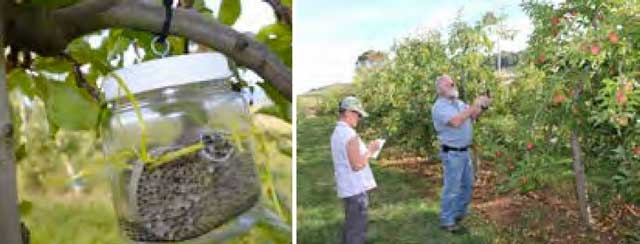Release of Mastrus in orchards
Release of Mastrus in orchards (cont from last issue)
To release Mastrus in orchards, parasitised codling moth larvae in corrugated cardboard bands are chilled and transported in portable coolers. The parasitised larvae are transferred into modified fruit fly traps which are then suspended from lower limbs of fruit trees (Figure 1). These are left until the adult wasps emerge and disperse.
The location of release sites is recorded for future reference (Figure 2).
Between 8000 and 20,000 Mastrus were released at each site and Mastrus adults were seen searching the trees for codling moth larvae about seven days after release.
Mass trapping
Until recently it has been difficult to catch female codling moths in traps.
A chemical ester isolated from pears and added to pheromone traps, changed that situation in apple orchards, but did not perform so well in pear orchards—probably because of competition from the pears themselves.
Addition of an extra plant volatile to the pheromone pear-ester mixture increased the capture of male and female codling moths in pear orchards treated with mating disruption.
Mass trapping using the enhanced lure in pear orchards under mating disruption, gave excellent control of codling moths.
By enhancing the potential for pheromone-mediated mating disruption to maintain codling moth populations and resultant fruit damage at low levels, mass trapping will complement biological control of codling moth.
It also reduces the risk of exposure to pesticides that may be toxic to the Mastrus ridens wasp.
Conclusion
The release of the codling moth parasitoid, Mastrus ridens, combined with mass trapping of codling moth females and the use of mating disruption, will potentially avoid the over-use of insecticide cover sprays and provide effective biocontrol of codling moth in pome fruit.
See this article in Tree Fruit March 2019




















